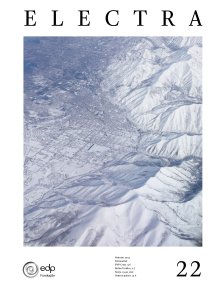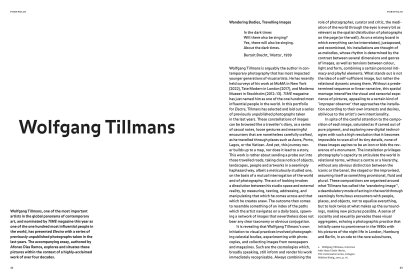Wandering Bodies, Travelling Images
Wolfgang Tillmans, one of the most important artists in the global panorama of contemporary art, and nominated by TIME magazine this year as one of the one hundred most influential people in the world, has presented Electra with a series of previously unpublished photographs taken in the last years. The accompanying essay, authored by Afonso Dias Ramos, explores and situates these pictures within the context of a highly-acclaimed work of over four decades.
In the dark times
Will there also be singing?
Yes, there will also be singing.
About the dark times.
Bertolt Brecht, 'Motto', 1939
Wolfgang Tillmans is arguably the author in contemporary photography that has most impacted younger generations of visual artists. He has recently held surveys of his work at MoMA in New York (2022), Tate Modern in London (2017), and Moderna Museet in Stockholm (2012–13). TIME magazine has just named him as one of the one hundred most influential people in the world. In this portfolio for Electra, Tillmans has selected and laid out a series of previously unpublished photographs taken in the last years. These constellations of images can be browsed like a traveller’s diary, as a series of casual notes, loose gestures and meaningful encounters that are nonetheless carefully crafted, as he travelled through places such as Accra, Porto, Lagos, or the Vatican. And yet, this journey never builds up to a map, nor does it lead to a story. This work is rather about sending a probe out into those travelled roads, taking close notice of objects, landscapes, people and artworks in a seemingly haphazard way, albeit a meticulously studied one, on the basis of a mutual interrogation of the world and of photography. The act of looking invokes a dissolution between his studio space and external reality, by measuring, testing, addressing, and manipulating that which he comes across and that which he creates anew. The outcome then comes to resemble something of an index of the paths which the artist navigates on a daily basis, spawning a network of images that nevertheless does not bear any clear taxonomy or obvious conjugation.
It is revealing that Wolfgang Tillmans’s own initiation to visual practices involved photographing celestial bodies, experimenting with photocopies, and collecting images from newspapers and magazines. Such are the cosmologies which, broadly speaking, still inform and render his work immediately recognisable. Always combining the role of photographer, curator and critic, the mediation of the world through the eyes is every bit as relevant as the spatial distribution of photographs on the page (or the wall). As on a mixing board in which everything can be interrelated, juxtaposed, and recombined, his installations are thought of as melodies, whose rhythm is determined by the contrast between several dimensions and genres of images, as well as tensions between colour, light and form, combining a certain personal intimacy and playful elements. What stands out is not the idea of a self-sufficient image, but rather the relational dynamic among them. Without a predetermined sequence or linear narrative, this spatial montage intensifies the visual and sensorial experience of pictures, appealing to a certain kind of ‘improper observer’ that approaches the installation according to their own interests and desires, oblivious to the artist’s own intentionality.
In spite of the careful attention to the composition of each image, saturated as if carved out of pure pigment, and exploring new digital technologies with such a high resolution that it becomes impossible to scan all of its tiny details, none of these images aspires to be an icon or bids the reverence of a monument. The installation privileges photography’s capacity to articulate the world in relational terms, without a centre or a hierarchy, without any obvious distinction between the iconic or the banal, the staged or the improvised, assuming itself as something provisional, fluid and plural. These compositions are organised around what Tillmans has called the ‘wandering image’1, a deambulatory mode of acting in the world through seemingly fortuitous encounters with people, places, and objects, not to equalise everything, but to look twice at what makes up the surroundings, making new pictures possible. A sense of sociality and sexuality pervades these visual aggregates, echoing a photographic practice that initially came to prominence in the 1990s with his pictures of the night life in London, Hamburg and Berlin, in an ode to the rave subcultures, the electronic music scene, or queer activism as spiritual and solidary manifestations. In exposing the intensity of love and loss without a sense of turmoil, but rather in an affirmative exultation, Tillmans privileged the intimacy of physical contact and private moments, though never as mere libidinous documents of those decades of social and political change. As Tillmans stated, what was at stake was also an attempt to understand the image itself as an analogue of the human body – at once a physical object and act, taking part in and opening up to the world.2 This affirmation of a new subjectivity in photographic practices could well be described as a form of intensity, as the very opposite of the idea of an ordered sequence, whose focus falls on instants of vital exuberance and bodily excess that cannot be articulated verbally. Pierre Klossowski defined the idea of ‘intensity’ as an existential experience that disrupts the order of philosophical discourse. Yet, here, this also entails a tribute to the wonder of looking as opposed to the stiffness of words, by opening up these pictures to the contingency and untranslatability of worldly things, with a sense of ease that challenges all description.
With a contemporary panorama that is consumed by and saturated with the idea of dystopia, boasting an obsessive attachment to irony and foreboding, and in a post-political moment which has profaned the utopian visions of three decades ago, sentencing us to a certain kind of ‘depressive hedonism’, as Mark Fisher defined it, Tillmans has recently taken a public stance through his activism in support of liberal democracy and the European Union, against Brexit and new waves of ethno- nationalism. At the same time, however, Tillmans’s work has retained its radical insistence on the idea of rescuing decisive moments of solidarity and empathy, celebrating the diversity and intensity of a corporeal existence in the world – not just the human body exposed in all of its vulnerability and rapture, but also the image as a body in and of itself, as sensitive and sensual matter, in a stance that is akin to recent philosophical conceptualisations of the political as, to use Lauren Berlant’s words, ‘that which magnetises a desire for intimacy, sociality, affective solidarity, and happiness.’ 3
The portfolio in this issue signals Tillmans’s tendency over the last decade to shift the focus from alternative subcultures to registering the surface of the world and the elegant banality of daily life, in a sublimation of the prosaic, exploring different states of being and searching for unexpected connections. This visual juxtaposition and accumulation conjures up something of the contemporary logic of images with their networks of instant distribution, at such a pace of circulation and consumption that the Debordian spectacle and the Deleuzian dispersal can no longer account for. All that which Tillmans extracts from the noise of the world chimes in with a new mode of looking which, to paraphrase Claire Bishop, lies somewhere between the subjective curiosity and the algorithmic, as a kind of arbitrary visualisation, boasting a certain instability of content that is self-actualised and self-regenerated, without a clear distinction between the meaningful and the banal.4 The process is highly specific, but the outcome is open-ended. This form of associative, quick, and scattered visualisation is emphatically different then from the historical compilation of images in the way of an atlas, in the hunt for any transhistorical affiliations and deep symptoms. This montage speaks to the structures of relationality that organise the lived experience of the present, with its endless and versatile flux of images that penetrate every nook and cranny of social life, but it also alludes to the transformation of the possibilities of identity and intelligibility of their publics in the last decades. In attempting to emancipate the image, multiplying and demultiplying it so as to open it up to new chains of relation, Tillmans makes it clear that the unbridled circulation of images is also something intimately intertwined with the idea of mobility, diversity and mutability of identities in the world in which we live.


Share article